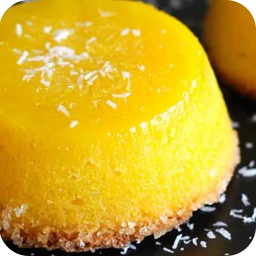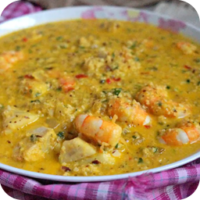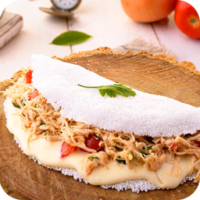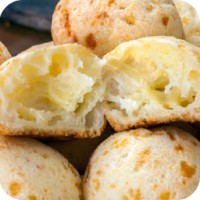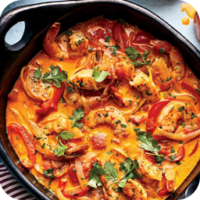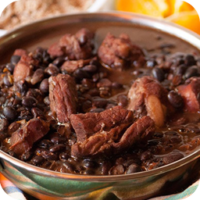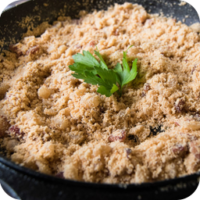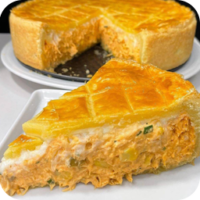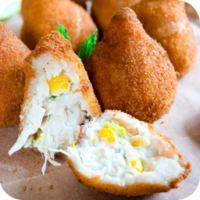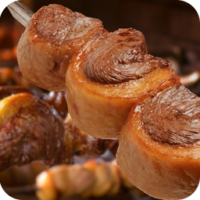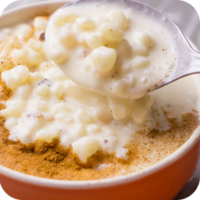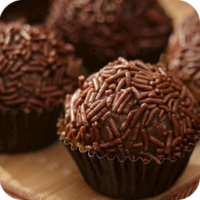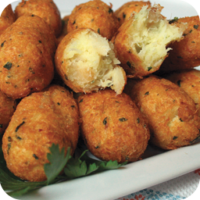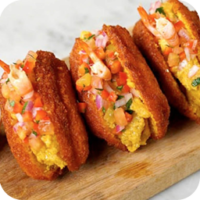Quindim is a traditional Brazilian dessert that originates from the country’s colonial period, with strong African influences. This sweet, bright yellow custard-like treat is made primarily from egg yolks, sugar, coconut, and butter. Quindim has a rich, smooth texture and a distinct sweet flavor, often served as individual portions in small, round molds.
Key Features of Quindim:
- Main Ingredients:
- Egg Yolks: The base of quindim, providing the custard-like texture and deep yellow color.
- Sugar: Adds sweetness to balance the richness of the eggs and butter.
- Coconut: Grated coconut is a key ingredient, providing both texture and flavor.
- Butter: Adds richness and a smooth finish to the dessert.
- Vanilla: Often used to enhance the flavor.
- Coconut Milk: In some variations, coconut milk is added to intensify the coconut flavor and creaminess.
- Preparation:
- The ingredients are mixed together to form a smooth batter.
- The mixture is poured into individual molds, often greased and sometimes lined with caramelized sugar.
- Quindim is baked in a water bath (bain-marie) until set, which gives it a soft, gelatinous texture.
- After baking, it is allowed to cool and is typically unmolded to reveal a shiny top and golden color.
- Serving:
- Quindim is usually served as individual portions, often unmolded and presented in small, round shapes.
- It is typically enjoyed chilled, making it a refreshing treat.
Cultural Significance:
- Colonial Influence: Quindim has roots in Brazilian colonial history, influenced by African and Portuguese culinary traditions. The use of coconut, eggs, and sugar reflects the mixture of native Brazilian, African, and European influences.
- Popular Dessert: It is a popular dessert in Brazilian households, often served during festive occasions, holidays, or family gatherings.
- Sweet Treat: Due to its rich, sweet flavor, quindim is a treat favored by those with a sweet tooth.
Variations:
- Traditional Quindim: The classic recipe includes egg yolks, sugar, coconut, and butter.
- Coconut Variations: Some recipes use coconut milk or incorporate other tropical fruits to enhance the flavor.
- Caramelized Quindim: The molds can be caramelized before adding the mixture, giving the dessert a subtle caramelized flavor.
Nutritional Value:
Quindim is a rich, calorie-dense dessert due to its sugar, egg yolks, and butter content. While it offers some nutrients from the coconut and eggs, it is high in fats and sugars, so it should be enjoyed in moderation.
Fun Fact:
- Quindim’s bright yellow color is largely due to the abundance of egg yolks, which give the dessert its iconic golden hue.
- The dessert is often served in individual portions, making it easy to serve at parties or gatherings.
Summary:
Quindim is a delightful Brazilian dessert made from coconut, sugar, and egg yolks. Known for its smooth, custard-like texture and vibrant yellow color, it is a
Quindim is a traditional Brazilian dessert that originates from the country’s colonial period, with strong African influences. This sweet, bright yellow custard-like treat is made primarily from egg yolks, sugar, coconut, and butter. Quindim has a rich, smooth texture and a distinct sweet flavor, often served as individual portions in small, round molds.
Key Features of Quindim:
- Main Ingredients:
- Egg Yolks: The base of quindim, providing the custard-like texture and deep yellow color.
- Sugar: Adds sweetness to balance the richness of the eggs and butter.
- Coconut: Grated coconut is a key ingredient, providing both texture and flavor.
- Butter: Adds richness and a smooth finish to the dessert.
- Vanilla: Often used to enhance the flavor.
- Coconut Milk: In some variations, coconut milk is added to intensify the coconut flavor and creaminess.
- Preparation:
- The ingredients are mixed together to form a smooth batter.
- The mixture is poured into individual molds, often greased and sometimes lined with caramelized sugar.
- Quindim is baked in a water bath (bain-marie) until set, which gives it a soft, gelatinous texture.
- After baking, it is allowed to cool and is typically unmolded to reveal a shiny top and golden color.
- Serving:
- Quindim is usually served as individual portions, often unmolded and presented in small, round shapes.
- It is typically enjoyed chilled, making it a refreshing treat.
Cultural Significance:
- Colonial Influence: Quindim has roots in Brazilian colonial history, influenced by African and Portuguese culinary traditions. The use of coconut, eggs, and sugar reflects the mixture of native Brazilian, African, and European influences.
- Popular Dessert: It is a popular dessert in Brazilian households, often served during festive occasions, holidays, or family gatherings.
- Sweet Treat: Due to its rich, sweet flavor, quindim is a treat favored by those with a sweet tooth.
Variations:
- Traditional Quindim: The classic recipe includes egg yolks, sugar, coconut, and butter.
- Coconut Variations: Some recipes use coconut milk or incorporate other tropical fruits to enhance the flavor.
- Caramelized Quindim: The molds can be caramelized before adding the mixture, giving the dessert a subtle caramelized flavor.
Nutritional Value:
Quindim is a rich, calorie-dense dessert due to its sugar, egg yolks, and butter content. While it offers some nutrients from the coconut and eggs, it is high in fats and sugars, so it should be enjoyed in moderation.
Fun Fact:
- Quindim’s bright yellow color is largely due to the abundance of egg yolks, which give the dessert its iconic golden hue.
- The dessert is often served in individual portions, making it easy to serve at parties or gatherings.
Summary:
Quindim is a delightful Brazilian dessert made from coconut, sugar, and egg yolks. Known for its smooth, custard-like texture and vibrant yellow color, it is a

